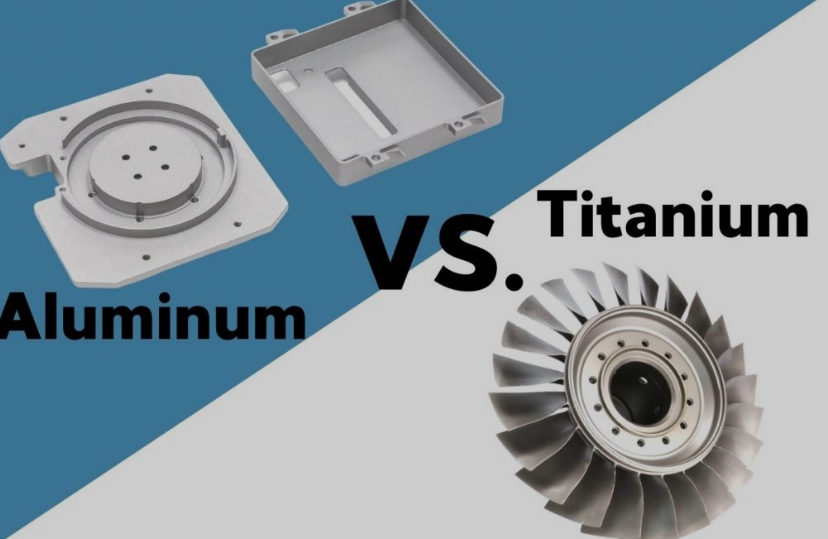Titanium and aluminum are both common metal materials, and they are also widely used in industrial applications. At the same time, there are many differences between titanium and aluminum. Titanium and aluminum have significant differences in performance, price and other aspects, which determines that their application prospects and market positioning in different industrial fields will be significantly different.

The Performance Difference between Titanium and Aluminum
Here is a comparison table of some key performance parameters of titanium and aluminum:
| Performance Parameters | Titanium | Aluminum |
| Density (g/cm3) | 4.5 | 2.7 |
| Thermal conductivity (W/mk) | 6.7 | 237 |
| Melting point (°C) | 1668 | 660 |
| Caused by oxides (Mainly) | TiO2 | Al2O3 |
| Material Cost | High | Low |
| Corrosion Resistance | Excellent | Fair |
| Processability | Average | Good |
| Strength (MPa) | 175-1000 | 70-300 |
| Modulus of Elasticity (GPa) | 105-114 | 70 |
Explanation of main indicators:
- -Density: Titanium has high density and light weight.
- -Thermal conductivity: Titanium has poor thermal conductivity, while aluminum has good thermal conductivity.
- -Melting point: Titanium has a high melting point and aluminum has a low melting point.
- -Oxide: Both easily form oxide films, but the quality of TiO2 film is better.
- -Cost: The cost of titanium is high and the cost of aluminum is low.
- -Corrosion resistance: Titanium has stronger corrosion resistance than aluminum.
- – Processability: Titanium has poor processability, while aluminum has good processability.
- -Strength: Titanium has a wide strength range, while aluminum has average strength.
- -Elastic modulus: Titanium has high elastic modulus.
What are the differences between the applications of titanium and aluminum?
Here is a table comparing titanium and aluminum in different applications:
| Applications | Titanium | Aluminum |
| Aerospace | ✔Aerospace structural components | ✔Civil aircraft accessories, engine casings, etc. |
| Sports equipment | ✔High-end bicycles, mountaineering equipment, etc. | ✔Rowing boats, roller skates, etc. |
| Medical devices | ✔Artificial joints, implants, etc. | ✔Steel structures for prosthetic limbs, etc. |
| Automobile | ✔High-priced body materials | ✔Body outer panels, wheels, etc. |
| Ships | ✔Warships, submarines, etc. | ✔Merchant ships, passenger ships, etc. |
| Chemical Industry | ✔Ting Chemical Process Equipment | ✔Ting Aluminum Chemical Products |
| Electrical | ✔Court conductor materials | ✔Court conductors, cables, etc. |
| National defense weapons | ✔battleship armor, missiles, etc. | ✔cannon shell casings, etc. |
| Household appliances | ✔High-end rice cookers for the home | ✔Washing machines for the home, refrigerator casings, etc. |
Main differences:
- -Titanium is more widely used in high temperature, strength, and corrosion resistance.
- –Aluminum applications are more in terms of non-toxicity, thermal conductivity, and cost.
- -Titanium is more suitable for high-end fields such as aerospace, national defense, and medical care.
- -Aluminum is more suitable for people’s livelihood fields such as transportation, electrical appliances, and housekeeping.
Price difference between titanium and aluminum
There is a big difference in price between titanium and aluminum:
| Material | Price |
| Aluminum | $12,000 – $16,000/ton |
| Titanium is about 10-20 times larger than aluminum |
The price ranges of various types of titanium materials are as follows:
| Type | Price (USD/ton) |
| TC4 Titanium Alloy | $25,000 – $28,000 |
| TC11 Titanium Alloy | $31,000 – $35,000 |
| TI6AL4V titanium alloy | $35,000 – $42,000 |
| High Purity Titanium | $49,000 – $56,000 |
Main reasons for price differences:
- -Aluminum resource reserves are large and titanium resources are scarce;
- -The extraction and refining process of titanium metal is relatively complex and the production cost is high;
- -The performance parameters of titanium, such as strength and corrosion resistance, are better than those of aluminum. It has a wide range of applications and a large demand.

